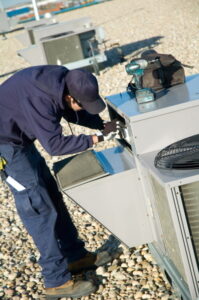What do you think you specifically need from your commercial HVAC system? Your first thought is likely “heating and cooling.” But your commercial facility’s HVAC system also needs to maintain proper airflow to avoid issues with high static pressure.
If you don’t know what static pressure is and why it’s important, don’t worry. We’re experts in commercial HVAC in Chicago, IL and we can guide you through the basics on why high static pressure is a concern for a commercial indoor environment, what causes it, and how to detect it.
Static Pressure
In simple terms, static pressure refers to the resistance against airflow inside the ductwork of an HVAC system. If you want to get technical, it’s the force that air molecules exert in a confined space, which in this case is the ductwork. In order for an HVAC system to work properly, the force of the air movement (supply static pressure) must be greater than the air resistance (return static pressure). If static pressure is too high, then there’s greater resistance to airflow in the HVAC system. Ideally, you want a balance of pressure.
Problems From High Static Pressure
The biggest negative impact from high static pressure is that it will cut into HVAC system efficiency due to the airflow resistance: the HVAC system must expend more energy to push the same amount of air. It also contributes to problems with air balancing and the even distribution of cooled and heated air around a facility. The extra labor placed on the HVAC system may also significantly shorten its service life, especially if the high static pressure is causing the system to cycle on and off more frequently than normal.
(And no, low static pressure isn’t necessarily better. In fact, it’s usually a warning that there are leaks in the ventilation system allowing air to escape from the ducts.)
Causes of High Static Pressure
Here are the most common reasons for an HVAC system to have an increase in static pressure:
- A clogged air filter: The air filters in the HVAC system need to be changed every few months. If left in place, a clogged filter will restrict airflow and create higher pressure.
- Poorly sized return air ducts: Unfortunately, some buildings have badly designed ductwork and vents that don’t allow enough airflow through the return air ducts, leading to higher pressure.
- Evaporator coil is too dirty/too small: When this refrigerant coil is too dirty, or if it’s too small for the system, it’s much like a clogged air filter—air cannot pass easily through it.
Signs of High Static Pressure
How can you tell that there’s a static pressure problem with your HVAC system? Look for these three signs:
- Hot and cold spots in the facility
- An unexpected spike in energy costs
- Louder HVAC system operation
There could be several different problems behind any of these symptoms, but that’s all the more reason to have professionals check it out.
What We Can Do
If you believe you have a problem with static pressure in your commercial HVAC system, reach out to us. We can check for pressure issues and identify where the problem is occurring, what’s causing it, and how we can correct it.
Contact Althoff Industries, Inc. for all your commercial HVAC needs. Challenges Accepted!

